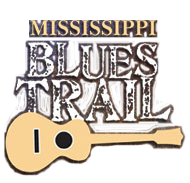B. B. King Museum
B. B. King Museum - Indianola
The B.B. King Museum & Delta Interpretive Center opened its doors in 2008 to pay tribute to the “king of the blues” and draw on his remarkable life to enlighten visitors about the history of the blues and the Delta region more broadly. King (1925-2015) performed at homecoming festivals on the grounds of the museum, where he was laid to rest. As a young man King worked in the brick cotton gin that was incorporated into the design of the museum, which was expanded considerably in 2021.
The B.B. King Museum & Delta Interpretive Center debuted on September 13, 2008, with a gala featuring King, his band and admirers from near and far. The initial exhibits in the 17,600-square-foot facility addressed important themes in King’s life: the early years in Mississippi; King’s career in Memphis including working as a DJ on WDIA; touring over 300 nights a year on the “chitlin’ circuit” during the segregation era; crossing over to a new audience in the 1960s; his subsequent life as an international icon; and the enduring importance to him of Indianola. The facility includes multiple interactive displays and ten original films, including an introduction to his life and career, all of which featured newly shot footage of King. In 2012 King purchased and then donated nearby Club Ebony to the museum, which holds events there. In 2021 a 4,800-square-foot wing was added that features one of King’s tour buses, personal vehicles and a display about his funeral, which took place in Indianola on May 30, 2015. The expansion also included the creation of the Memorial Pavilion surrounding King’s grave that welcomes those who come to pay their respects.
King famously proclaimed Indianola as his “hometown” and celebrated it in many ways, including naming his 1970 album Indianola Mississippi Seeds. He was actually born in rural Berclair, about 18 miles to the east, and settled in the city in 1943 at 17. He found here a welcoming and supportive community, worked as a tractor driver, married, performed in a gospel group that enjoyed regional success, and began to play the blues. His musical career took off after he settled in Memphis in the latter ‘40s, but King would return regularly for the rest of his long life to perform at Club Ebony, visit friends, attend annual homecoming events in his honor that began in 1980, and from 2008 took place at the B.B. King Museum. The prior homecoming events included a daytime outdoor show in city parks and an intimate concert at Club Ebony that typically went into the wee hours of the following morning.
In the early 2000s, a group of locals organized to plan a museum that would celebrate King. The famously humble musician was initially resistant, but King ultimately agreed that telling his story could educate people about the community and the history and meaning of the blues. This location, with its brick cotton gin, built circa 1905, was chosen by two architectural surveys to be a desirable site for the museum before King revealed it was his former workplace in the ‘40s. The museum’s construction and programming marked a dramatic increase in recognition for the blues across the state. Notably, the Mississippi Blues Trail, which began in December of 2006, was an outgrowth of the museum planning process.
This is marker No. 220 on the Mississippi Blues Trail, dedicated September 5, 2025. Text by Scott Barretta.
[ BACK TO TOP ]

